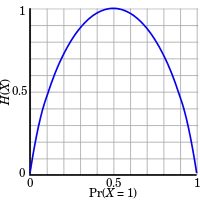Binary entropy function
In information theory, the binary entropy function, denoted or , is defined as the entropy of a Bernoulli process with probability of one of two values. It is a special case of , the entropy function. Mathematically, the Bernoulli trial is modelled as a random variable that can take on only two values: 0 and 1, which are mutually exclusive and exhaustive.

If , then and the entropy of (in shannons) is given by
- ,
where is taken to be 0. The logarithms in this formula are usually taken (as shown in the graph) to the base 2. See binary logarithm.
When , the binary entropy function attains its maximum value. This is the case of an unbiased coin flip.
is distinguished from the entropy function in that the former takes a single real number as a parameter whereas the latter takes a distribution or random variable as a parameter. Sometimes the binary entropy function is also written as . However, it is different from and should not be confused with the Rényi entropy, which is denoted as .
Explanation
In terms of information theory, entropy is considered to be a measure of the uncertainty in a message. To put it intuitively, suppose . At this probability, the event is certain never to occur, and so there is no uncertainty at all, leading to an entropy of 0. If , the result is again certain, so the entropy is 0 here as well. When , the uncertainty is at a maximum; if one were to place a fair bet on the outcome in this case, there is no advantage to be gained with prior knowledge of the probabilities. In this case, the entropy is maximum at a value of 1 bit. Intermediate values fall between these cases; for instance, if , there is still a measure of uncertainty on the outcome, but one can still predict the outcome correctly more often than not, so the uncertainty measure, or entropy, is less than 1 full bit.
Derivative
The derivative of the binary entropy function may be expressed as the negative of the logit function:
- .
References
- Topsøe, Flemming (2001). "Bounds for entropy and divergence for distributions over a two-element set". JIPAM. Journal of Inequalities in Pure & Applied Mathematics. 2 (2): Paper No. 25, 13 p.-Paper No. 25, 13 p.
Further reading
- MacKay, David J. C. Information Theory, Inference, and Learning Algorithms Cambridge: Cambridge University Press, 2003. ISBN 0-521-64298-1